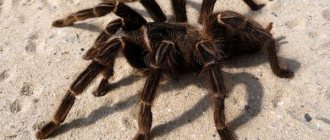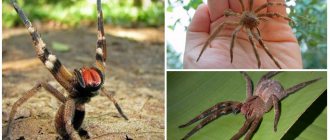Appearance, structure
Conventionally, the body of a spider is divided into the abdomen and cephalothorax. The insides are protected by a durable chitinous cover. The spider's eyes are located on the front of the chest - the head: 4 pairs, providing the tarantula with a wide visual range. The spider sees shadows, silhouettes, movement. The organs of smell and touch help to navigate in space.
The spider has 8 legs, attached to the cephalothorax, a pair of chelicerae. The legs are massive and long. The largest tarantula in the world - 28 cm, was included in the Guinness Book of Records. On average, the size of the spider including its legs is 25 cm. The color of the tarantula is bright and exotic. The paws are shaggy, the body is covered with bristles. The average weight is 85 g. Brazilian tarantulas weigh about 150 g. The largest goliath is 170 g. A photo of a tarantula spider is located below.
Interesting!
The body is covered with poisonous hairs. The spider weaves them into its web when building a nest, a cocoon for the larvae. Shakes off for self-defense. Some species of tarantulas defend themselves in an original way - they spray excrement towards the enemy, thereby diverting attention.
Goliath Spider (Theraphosa blondi)
Leg span - up to 28 cm.
Goliath Spider (Theraphosa blondi)
In honorable first place, the Goliath spider, the largest and heaviest spider in the world, has already woven its web. Found in the tropical forests of Guyana, Suriname, Venezuela and northern Brazil.
It can bite, the consequences are comparable to a wasp sting. Stinging hairs are also dangerous. If threatened, the spider combs them towards the enemy. When they get on the skin and eyes, they cause irritation that will last for several days.
It is not easy to notice a huge arthropod. Thanks to its color, it blends in with the ground, and settles in the deep burrows of rodents, which it managed to defeat in a fight. The entrance to the lair is covered with cobwebs. The offspring of the world's largest spider can be eaten by scorpions, centipedes, toads and ants. And adults should avoid people who catch goliath for gastronomic purposes. Its meat is said to taste like shrimp.
The Goliath spider hunts without using a web. It waits for the victim, pounces and bites, injecting paralytic poison. Those who wish can keep such a spider in a home terrarium, but it is worth remembering that its bite can kill a cat and a small dog.
Photos and descriptions of the most striking species
Exotic lovers buy colorful spiders for a lot of money. In terrariums with proper care, the pet lives up to 25 years. You can see the photos below to see what the animal looks like.
Chilean rose tarantula (Grammostola rosea)
In natural conditions it lives in the USA. Most common in Chile, hence the name. In terms of sales in pet stores, it is one of the most popular and expensive. The size of an adult animal is 16 cm. Hairy legs, body covered with hairs. The color is brown, sometimes pink, the body is covered with light hairs. The pink spider has a non-aggressive temperament, does not attack people, and bites only in self-defense.
Chilean rose tarantula
On a note!
The lifespan of a female is 15-20 years, but it can be longer. How long they live in natural conditions is not known for certain.
Blue tarantula spider (Cyriopagopus sp. Blue)
An exotic species discovered in Malaysia. Large blue tarantula. Together with the leg span, the size is 25 cm. The entire body and legs are covered with long thick hairs. The colors are the same everywhere with different tints of blue, cyan, and purple.
The predator is poisonous, with an aggressive disposition, and requires special care when kept as a pet. The female reaches sexual maturity after 3 years. Blue, blue, and purple tarantulas live in nature for more than 20 years. Throughout life they molt several times and change color slightly. The female lays up to 150 large eggs at a time in a self-formed cocoon.
Blue tarantula spider
Tiger tarantula (Psalmopoeus irminia)
The species was discovered in 1994 in Venezuela. The maximum body size is 6 cm, with a leg span of 14 cm. Life expectancy is 15 years. Feels good in artificially created conditions. It is recommended for a confident beginner or an experienced collector to keep it as a pet, since the arboreal tarantula is aggressive, poisonous, and nimble.
The female reaches sexual maturity at 2 years and lays up to 200 large eggs in a cocoon. In the natural environment, it is capable of laying another clutch without prior fertilization. Males are much smaller in size and become sexually mature at 1 year.
Tiger tarantula
On a note!
Externally - one of the most beautiful views. The body with paws is covered with shiny black hairs. The abdomen has a characteristic red or light brown pattern, reminiscent of the coloring of a tiger.
Mexican red-knee tarantula (Brachypelma smithi)
Lives in desert, arid places in Mexico. They live in burrows underground, cracks in the rock. Body size including legs is 12 cm. Poisonous, moderately aggressive. Life expectancy is about 15 years. The coloring of the exotic animal is unique and attractive. The main tone is black, the hairs are light gray, on one segment of the limb, the cephalothorax has bright red spots, a rectangular pattern. The female sheds throughout her life; in males, this process stops after reaching puberty.
Brachypelma albopilosum spider
Calm, slow, poisonous, but not dangerous to humans. Bites and sheds toxic hairs for self-defense. Lives in the tropics, mates during the rainy season. An immature female behaves aggressively and can even kill her “suitor.” Color range – black, brown, beige. Body size with paws is 15 cm. It grows slowly, the female lives up to 20 years. It lays eggs in a cocoon, up to 500 at a time.
Spider Brachypelma albopilosum
Mexican tarantula spider (Brachypelma emilia)
One of the brightest representatives of a large family. They were the first to be exported from Mexico to Europe as a pet. The size of the animal is 16 cm with splayed limbs. Has a calm, non-aggressive disposition. Under natural conditions, it is active at night and hides in secluded places during the day. The female lives for 20 years.
On a note!
Emilia reproduces rarely, abnormally. 8 months may pass after fertilization. The eggs are laid in a self-formed cocoon or a suitable shelter for this. Beginners can keep a pet, but breeding should be done by professionals.
Mexican tarantula spider
Brazilian pink tarantula (Lasiodora parahybana)
Leg span - up to 25 cm.
Brazilian pink tarantula (Lasiodora parahybana)
The third largest spider in the world is the Brazilian pink tarantula. Found in the wild in the forests of Brazil. Sensing danger, it combs stinging hairs from the body, which are irritating and can cause an allergic reaction. Not very aggressive towards people. The pink tarantula neurotoxin is of little danger to humans, but can be fatal to domestic animals. The pain is comparable to a cat bite with a high probability of suppuration.
This giant easily reproduces in captivity, is active and unpretentious, therefore it is a popular resident of home terrariums. Keepers are also attracted by its amazing growth rate. In a year, under the right conditions of keeping and feeding, it can reach 15 centimeters in paw span.
Habitats of tarantulas in nature
Distributed throughout the globe. Most species live in tropical countries - America, Mexico, Africa, Australia. Some varieties are found in Europe - Spain, Italy, Portugal.
In natural conditions, tarantulas live on trees, shrubs, as well as in soil and rocks. It often happens that nymphs initially live underground in burrows, and when they mature, they move to trees. Almost all tarantulas are slow, making sudden movements in case of urgent need. Well-fed females may not leave the shelter for several months.
Interesting!
How long a female can live depends on living conditions. Some species live up to 30 years. They shed periodically, increase in size, and change color somewhat. Males die immediately after mating or within a year. Weakened “suitors” can be eaten by the female after mating.
Giant huntsman spider (Heteropoda maxima)
Leg span - up to 30 cm.
Giant huntsman spider (Heteropoda maxima)
Not the heaviest, but probably the longest-legged spider in the world lives in the Laotian province of Khammouan. Inhabits hard-to-reach caves. It was first described in 2001 by P. Jäger. It's amazing that the Giant Huntsman Spider went undetected for so long. Very little is known about him.
What does a tarantula spider eat?
The lifestyle of different species is somewhat different. Some representatives of the genus do not form trapping nets, they watch over prey from shelters, others weave a huge web with a diameter of up to 2 m. The web is so dense that it holds birds, small rodents, lizards, frogs, and snakes. The main diet consists of insects, beetles, and small spiders.
The tarantula infects the victim with poison, paralyzes it, and injects saliva, which liquefies the insides in a few minutes. The spider sucks up the contents, leaving only a chitinous cover of the prey. The toxic substance affects the nervous system, causing spasms and suffocation.
Interesting!
From the name you might think that spiders eat birds and feed on meat. In reality, this is not entirely true. It is difficult for tarantulas to digest solid food, so they still prefer insects.
Royal baboon spider (Pelinobius muticus)
Leg span – up to 20 cm.
Royal baboon spider (Pelinobius muticus)
It got its name not because it ate monkeys, but because of the resemblance of its last pair of legs to those of a baboon. The baboon spider lives in East Africa. It grows very slowly.
Spends most of its time in burrows, which it digs independently with the same massive hind legs. The vertical pit can reach 2 m in depth and ends in a horizontal living chamber. The entrance and the entire tube of the mink are woven with cobwebs. This helps the spider sense vibrations from potential prey on the surface.
Baboon spiders rarely leave their burrow. They feed on any animals they can overcome. They have an aggressive disposition. When irritated they make hissing sounds. They are very poisonous, but their toxin usually does not pose a threat to human life.
Reproduction
Males reach sexual maturity at the age of 1-2 years, females at 2-5 years. Before the mating season, males weave a web and apply seminal fluid to it. During the mating season, the spider collects sperm in a special bag - the cymbium, and crawls towards the female. The hooks hold her sexual organ and fill her with seminal fluid.
After fertilization, the female becomes aggressive; if the male does not have time to escape, she risks being eaten. After 1-8 months, the female begins to form a cocoon from the web, laying from 50 to 2000 eggs there. Embryos develop from several weeks to months - 20-106 days. All this time, the female protects the cubs and periodically turns over the cocoon. However, if there is a shortage of food, it can eat it all.
Tarantula Reproduction
Spiders are born weak and inactive. They don’t feed for some time, so they coexist quite peacefully. After the first molt, they increase in size and acquire a characteristic color. The tarantula grows slowly. The female sheds almost her entire life, even after becoming a sexually mature individual.
Interesting!
Before shedding its old skin, the tarantula stops eating, weaves a rug out of its web, turns over on its back, and pulls off its cover. The spider molts during its adult stage every month. After puberty in males, this process stops; the female molts every year. Together with the old coat, the animal sheds parasites, fungi, bacteria, and renews the poisonous coat of villi.
Danger to humans
All tarantula spiders are poisonous. If they talk about a safe animal, this means poison of low toxicity. There are no officially registered cases of human death from a bite. However, there is information that cats have died from pets. Often the bite occurs dry - without injecting poison. Then only a small hematoma remains at the site of the attack.
An allergic reaction to a toxic substance depends on the state of the immune system and age. Spider bites are potentially dangerous for children, people prone to allergic reactions, and the elderly. Possible consequences are local skin allergies, breathing difficulties, muscle spasms, vomiting, abdominal pain, weakness, dizziness.
In natural conditions, spiders shed poisonous fibers when there is a threat to their own lives, and weave them into the web when forming a cocoon with eggs or a nest. In the terrarium, the tarantula sheds its lint due to stress. Inhaling them leads to the development of allergies - rhinitis, cough, shortness of breath, difficulty breathing, lacrimation, etc.
At home, tarantulas are kept in terrariums and fed with insects. It is impossible to train or accustom spiders to anything.
They are usually harmless
0
Source:
But if nothing threatens them, goliath tarantulas are completely harmless. They just don't like it when someone bothers them and stands in their way. Although this spider is venomous, it rarely injects venom when biting unless it is hunting. If such a spider bites you and injects venom, you will feel pain and the bite site will swell. It will be like a wasp sting.











